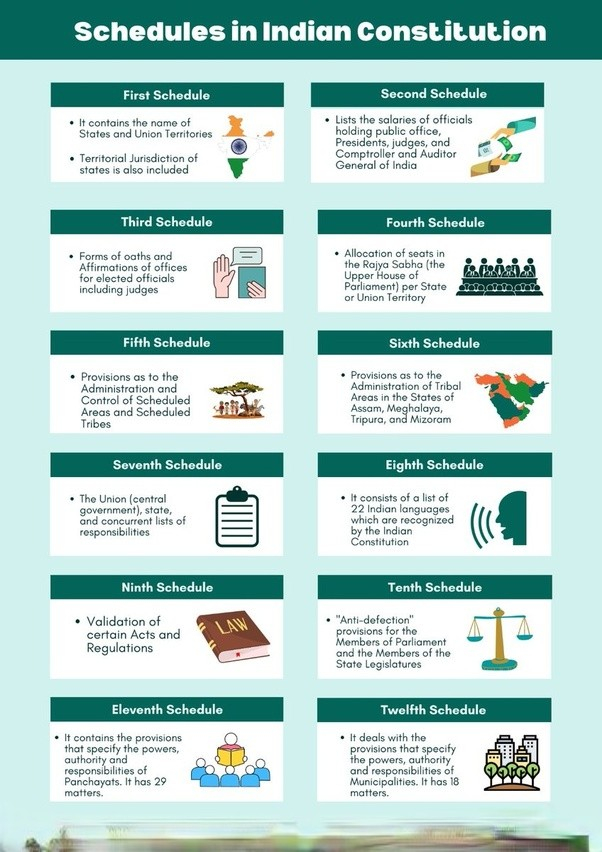Introduction to the Schedules of the Indian Constitution
The schedules featured in the Indian Constitution encompass vital details about territories, seat allocation in the Rajya Sabha, governance and oversight of scheduled areas and tribes, as well as the delineation of powers between the Central government and state governments. Additionally, they outline the perks and privileges accorded to high-ranking officials. Although these schedules exist as distinct documents, they form an integral part of the broader Indian Constitution.
During its inception in November 1949, the Indian Constitution comprised only eight schedules. The Ninth Schedule was subsequently introduced through the First Constitutional Amendment Act of 1951. In 1985, the Tenth Schedule, addressing the anti-defection law, was incorporated with the 52nd Constitutional Amendment Act. Seven years later, the 73rd and 74th Constitutional Amendment Acts were enacted, leading to the inclusion of the 11th and 12th schedules.

Schedules of the Indian Constitution
Currently, the Indian Constitution comprises 12 Schedules and 25 Parts, each playing a crucial role in delineating the structure and functioning of the nation. The concept of Schedules originated in the Government of India Act, 1935, which initially featured 10 Schedules. Upon the adoption of the Indian Constitution in 1949, there were eight Schedules. Subsequent amendments have brought the current total to 12 Schedules, each addressing specific aspects of governance.
Let’s delve into the details of each Schedule:
- 1st Schedule:
The 1st Schedule outlines the names of Indian states and union territories, along with their respective territories and jurisdictions. It is closely associated with Article 1 and Article 4 of the Constitution. - 2nd Schedule:
The 2nd Schedule details provisions concerning the President, Governors of States, and various other officeholders. This includes the Speaker and Deputy Speaker of the House of the People, Chairman and Deputy Chairman of the Council of States, among others. - 3rd Schedule:
Prescribing oaths and affirmations for public officials and legislative members, the 3rd Schedule is linked to Articles 75, 84, 99, 124, 146, 173, 188, and 219. - 4th Schedule:
Focused on the allocation of seats in the Rajya Sabha, the 4th Schedule pertains to each state and union territory, and it is associated with Article 4 and Article 80. - 5th Schedule:
Addressing the administration and control of scheduled areas and tribes, the 5th Schedule provides special protection and safeguards, related to Article 244. - 6th Schedule:
Pertaining to autonomous districts and regions in Assam, Meghalaya, Tripura, and Mizoram, the 6th Schedule grants specific administrative and legislative powers, connected to Article 244 and Article 275. - 7th Schedule:
Arguably the most critical, the 7th Schedule distributes legislative subjects between the central and state governments, categorized under Union List, State List, and Concurrent List. It is related to Article 246. - 8th Schedule:
Listing officially recognized languages, the 8th Schedule, under Article 344 and Article 351, currently includes 22 languages, such as Hindi, Bengali, Tamil, and Urdu. - 9th Schedule:
Added by the First Amendment Act of 1951, the 9th Schedule shields certain laws from judicial scrutiny. It deals with state acts and regulations related to land reforms and the abolition of the zamindari system, linked to Article 31-B. - 10th Schedule:
Enacted through the 52nd Amendment Act in 1985, the 10th Schedule, known as the “Anti-Defection Law,” addresses political defection and outlines provisions for the disqualification of members of Parliament and State Legislatures, connected to Article 102 and Article 191.
In conclusion, the Schedules of the Indian Constitution are integral components that enrich its provisions, providing depth and clarity. These schedules contribute to the adaptability and comprehensiveness of the Indian Constitution, making it a significant subject in various government job examinations like UPSC, SSC, NDA, and CDS.
F.A.Q.
- Q. What is 8th schedule of Indian Constitution?
Answer :- Listing officially recognized languages, the 8th Schedule, under Article 344 and Article 351, currently includes 22 languages, such as Hindi, Bengali, Tamil, and Urdu.

[…] For all list of Schedule of Indian constitution […]